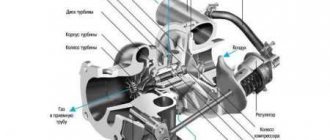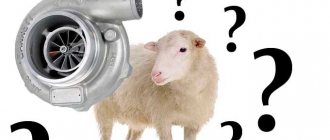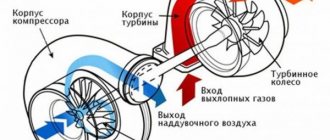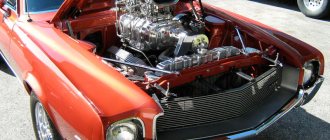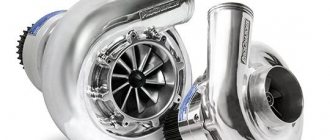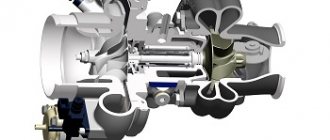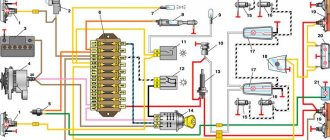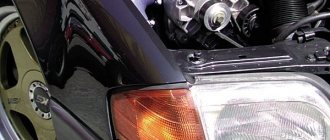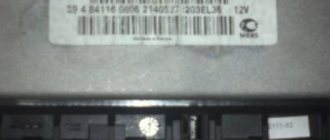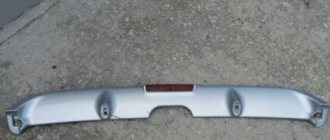Installing a turbine is the most common way to improve the power characteristics of VAZ cars. Atmospheric modification of the engine with a cylinder head bore, a sports exhaust system and sports shafts will be more affordable, but it is limited to a limit of 120-130 hp. Proper turbocharging allows you to remove more than 200 horses from a car. When choosing between turbocharged and naturally aspirated engines, proceed from the tasks assigned to the car. Refinement of the naturally aspirated engine allows you not to get lost in city traffic among more powerful foreign cars. Turbo is better for racing.
In addition, it is almost impossible to legalize a turbo engine in a VAZ in Russia.
Installation of a turbine on an 8 valve VAZ 2114 engine
Installing a turbine is the most common way to improve the power characteristics of VAZ cars. Atmospheric modification of the engine with a cylinder head bore, a sports exhaust system and sports shafts will be more affordable, but it is limited to a limit of 120-130 hp. Proper turbocharging allows you to remove more than 200 horses from a car.
When choosing between turbocharged and naturally aspirated engines, proceed from the tasks assigned to the car. Refinement of the naturally aspirated engine allows you not to get lost in city traffic among more powerful foreign cars. Turbo is better for racing.
In addition, it is almost impossible to legalize a turbo engine in a VAZ in Russia.
Installation Features
How much does an 8 valve engine on a VAZ 2110 weigh?
A compressor of this type for a VAZ involves the use of the following factory elements: cylinder block, crankshaft, connecting rods, camshaft and valves. Differences in additional elements are associated only with the pistons and cylindrical head due to the need to reduce compression during installation. This functional feature is achieved by expanding the combustion chamber or special pistons. But, there is a version that the latter may be factory-made, and you can limit yourself to replacing the head.
The turbine on the VAZ 2107 injector also has differences in output. It fills the area between the receiving pipe and the exhaust manifold. The factory components will remain the muffler and resonator. If you need to get more power, it is better to use the recommendations for installing a direct-flow type exhaust. Injection requires a larger receiver and a non-standard control solution. The lubrication system is also subject to certain changes. As a result, the most expensive element is the turbine.
Nuances of work
Why is a turbocharger attractive to a VAZ owner? The volumes of fuel that burn out inside the cylinders are closely related to the amount of air entering the injector during startup. Enrichment of the liquid requires reducing power. In order to remove this limitation, the cylinder requires a much larger supply of air when excess pressure is pumped. Just like that, increased pressure by thirty percent triggers the required level of increase in power and dynamic acceleration.
The operation of a compressor of this type on an injector is extremely simple. The housing is fixed to the exhaust manifold. At the core of the device there is a turbine wheel connected to a compressor wheel. The exhaust gas stream spins the turbine. Then, through the shaft, the moment goes to the compressor impeller, which sucks in air through the corresponding filter, then transferring it to the carburetor already compressed, thus increasing the level of saturation of the cylinders.
So cylinders of equal volume pump working mixtures in large numbers. Conventional VAZ engines have a 25 percent combustion level of the pumped fuel due to lack of oxygen.
Increased air filling includes a uniform increase in the amount of fuel burned.
This fact will affect the efficiency level of the motor. As a result, the supercharger will allow you to pump large volumes of gasoline over a similar period of time. The instantaneous characteristics will also increase, affecting the acceleration dynamics.
INSTALLING A TURBO ON A VAZ 2114: WHERE TO START
Installing a turbine on any car begins with a thorough examination of the hardware. You can’t just go to the store and buy a ready-made kit. And even if it is possible, the system will still have to be modified.
Turbocharged engine VAZ 2114
If you take on this task, consider the following:
- A number of stock units of the VAZ 2114 are unsuitable for a car with a power of over 150 hp. It will not be possible to do without re-equipping the suspension and brakes, installing wider wheels with a turbo engine.
- Tuning foreign cars is partly easier if the model being tuned has “bigger” brothers with turbo engines. Tuning usually comes down to searching, purchasing and adjusting ready-made factory units. It’s more difficult with Togliatti-made cars - VAZs don’t install turbines. Fortunately, in large cities there are tuning studios that develop and produce tuning parts. True, their products are mostly unlicensed, so there will be problems with legalizing changes.
- The correct choice of turbine is the key to successful turbo tuning. Before realizing your dream, we recommend that you read brief descriptions of the turbines used to modify the VAZ.
Turbo kit for VAZ 8v up to 250 hp
A set of parts to increase the power of VAZ Samara and Samara 2 cars up to 250 horsepower. Designed for cars equipped with a 16 valve VAZ 2112 / 21124 engine. The declared power is achieved by installing a TD05H-16g turbocharger. Boost pressure 1 bar.
| 1 | PC. | |
| 1 | PC. | |
| Hairpin M10 | 3 | PC. |
| Bolt M10 x 30 x 1.25 | 2 | PC. |
| Nut M10x1.25 | 8 | PC. |
| 1 | PC. | |
| Banjo bolt M10×1.5 | 1 | kit |
| 1 | PC. | |
| 1 | PC. | |
| Copper washer 10 mm | 2 | PC. |
| Copper washer 14 mm | 6 | PC. |
| Banjo bolt M14×1.5 | 2 | kit |
| 2 | PC. | |
| 1 | PC. | |
| 1 | PC. | |
| Silicone pipe, 28 mm | 1 | PC. |
| Clamp 25/40 | 2 | PC. |
| Blow off Forge | 1 | PC. |
| 1 | PC. | |
| 1 | PC. | |
| Air temperature sensor | 1 | PC. |
| DBP Motorola 6250 (1.5 bar) | 1 | PC. |
| 1 | PC. | |
| 1 | kit | |
| 1 | PC. | |
| 1 | kit | |
| 1 | kit | |
| 1 | PC. | |
| Cylinder head gasket VAZ 2112 | 1 | PC. |
| 1 | PC. | |
| Hairpin M6*22 | 2 | PC. |
| M6 nut with skirt | 2 | PC. |
| 2 | m |
Attention! Kit for vehicles with manual throttle. Installation will require modification to the car body.
After installation, it is necessary to configure the engine control unit.
PRICE 67,500P
TURBINES FOR VAZ CARS
There are many options for installing a turbine on the 2114 model. Theoretically, anything can be adapted, but the following models are best suited for an 8-valve engine:
- Garret 1752;
- Mitsubishi TD04 (installed on Mitsubishi Lancer EVO, Subaru Impreza WRX, and some other models);
- IHI VF10 (this model was equipped with the 1st generation Subaru Legacy cars), as a variant of the VF11-20 (stock for the 2nd generation Legacy);
The list can be expanded with dozens of positions, including more powerful turbines TD05, TD06, VF23-30.
Moreover, if there is not enough money for new equipment, it is not difficult to find used kits in decent condition due to the transition of their owners to more powerful equipment
Pros and cons of turbine, compressor and naturally aspirated engine
Let's consider all these methods of engine tuning separately.
Turbine
Under the hood of a turbocharged VAZ-2112
In recent years, the installation of turbines on cars of the VAZ family has become quite widespread. And there is nothing unexpected about this, since they are the most common, unlike mechanical inflation (compressor - approx.), because they have a number of advantages.
Firstly, the supercharger is located next to the turbine impeller and is built into the exhaust manifold, driving itself with exhaust gases. Secondly, such an arrangement of components can significantly increase the efficiency of the entire engine, because there is no direct connection between the turbine and the crankshaft, since it does not take power from the engine itself. Experienced auto mechanics call this the main advantage of a turbine over a compressor.
Turbine disadvantages
However, the turbine has its drawbacks, and these include “turbo lag”. This effect manifests itself in a slow response to pressing the gas pedal, and at low speeds the turbine operation will not be felt at all. The explanation for this is very simple: in order for the engine to begin to gain power and speed, it requires time for the exhaust gas pressure to increase, which would be able to properly spin the turbine. For exactly the same reason, a turbocharged engine is capable of producing maximum power only after 4000 rpm.
Compressor
The compressor engine starts air movement due to a special mechanical supercharger operating using a belt drive. That is, the operation and power of the engine directly depends on the number of revolutions gained and the higher they are, the higher the power. In the design of the compressor, the air mixture with fuel is not only supplied to the cylinders under pressure, but is also capable of blowing through the exhaust and intake valves when they are not completely closed, thereby cleaning them. Because of this design, the engine is always able to operate at full power.
Disadvantages of the compressor
A significant disadvantage of such a modification is the unreliability of the drive belts, which will one way or another break and become unusable, as well as increased fuel consumption, since the compressor is best installed on engines with a large volume, since the efficiency of interaction with them will be much higher.
Atmospheric engine
When talking about an atmospheric engine, many people think of anything but what actually exists.
The atmospheric engine is both simple and the most complex in its design. Since the ideal fuel-air mixture is supplied to the cylinders of this engine, without any obstacles or resistance in its path. The manifold works perfectly on this engine, the camshaft is adjusted as precisely as possible, the cylinder diameter, piston stroke, and so on are increased. And all this is done to increase the rated power of the engine.
Despite the fact that this is a seemingly ideally built engine, the advantages of which include the strictly accurate response of the gas pedal and a good reserve of power at any speed, it also has disadvantages in comparison with its turbocharged counterpart.
Cons of a naturally aspirated engine
- The first disadvantage due to which you can give preference to the “turbo” is the very high fuel consumption and the high degree of wear of the internal parts of the engine. It is also impossible for a naturally aspirated engine to more than double the stock power, whereas a turbocharged engine can increase it several times.
- Heavily promoted “aspirated” engines only drive at high speeds, which has a negative effect when driving in urban conditions. They also have a high idle threshold, which is also inconvenient for everyday use.
TURBO KIT GARRET 1752
Turbo kit Garret 1752
Turbines from Garrett are consistently among the most popular among VAZ owners.
Among the reasons for this:
- sold as a ready-made set, there is no need to assemble individual elements using spare parts at car dismantling yards;
- relatively low cost (a new set will cost 30-35 thousand, used ones can be found in the range from 15 to 25 thousand);
- without any special modifications, you can remove the boost from the car to 0.5 bar, increasing power to 120-130 hp. and torque up to 180-200 Nm;
- with additional modifications to the boost system, the boost can be increased to 1 bar, power – up to 170-200 hp, and torque – up to 240 Nm.
The boost kit from Garret is optimal for novice fans of turbo tuning. By setting the boost to 0.5 bar, you can get a good increase in power without reducing engine life. For serious “rides,” this option is not suitable due to its limitations.
Exhaust system improvements
Exhaust system modifications consist of several activities:
- Installation of a flame arrester.
- Replacing the standard muffler with the Turbo tema model.
- To muffle the roar of the improved heavy-duty motor, a Helmholtz resonator is welded in.
- For the muffler, add another bracket and another muffler retaining pad.
- Replacing the standard receiver with a 128 receiver.
- Almost all the parts that are required to modify the systems and components of the Lada Priora are included in the engine tuning kit.
TURBINES BASED ON TD04 TURBO-COMPRESSOR
Turbine TD04L with actuator
The Mitsubishi TD04 compressor and its various invariants (TD04H, TD04L, TD04HL and others) are one of the most common Japanese turbo systems in Russia. Installed on Mitsubishi Lancer Evolution IV-V generations, turbodiesel Mitsubishi Pajero, as well as many Subaru models of the mid-1990s.
The advantage of this compressor is that in the factory version it made it possible to extract a solid 280 - 340 Nm and 280 hp from 1.6 - 2.0 liter engines. In addition, it is compactly placed under the VAZ hood.
High-performance turbos like the Garret GTX30 (installed on the Toyota Chaser or Mark II and German BMW e39 cars) are more difficult to place under the hood. There are precedents, but doing it on your own is not easy.
The build quality of the Japanese turbine is higher than the Chinese Garrett, and the resource reserve allows you to purchase even well-worn equipment. A distinctive feature of the turbine is its flat torque level. Peak performance varies depending on the type of compressor and additional equipment.
For racing where acceleration is of paramount importance, it is better to consider other turbos. On tracks with long straights, where it is possible to fully use the maximum revs of 4 - 4.5 thousand, the TD04 can compete with more productive models.
Turbocharger for KamAZ: types, manufacturers, prices
Currently, on various modifications of KamAZ you can find engines of four environmental classes - from Euro 0 (only on older models) to Euro 3.
Euro 0 class consists of two engines:
– KamAZ 740.10; – KamAZ 7403.
On sale you can find turbochargers only for various modifications of the KamAZ 7403 engine - these are the well-proven TKR7N-1. But the Euro 0 class is gradually being replaced, so the time is very close when such turbochargers simply will not exist.
Euro 1 class includes two popular engines:
– KamAZ 740.11; – KamAZ 740.13.
A large number of turbochargers are available for these engines, including various modifications of TKR7 and K27, as well as foreign units from CZ Strakonice (Czech Republic) and Schwitzer (Germany).
Euro 2 class is one of the most common; four engines correspond to this class:
– KamAZ 740.31-240; – KamAZ 740.30-260; – KamAZ 740.50-360; – KamAZ 740.51-320.
These engines are equipped with the turbochargers already mentioned above in Euro 2 modifications.
The Euro 3 class is by far the highest class of KamAZ engines and includes five units:
– KamAZ 740.60-360; – KamAZ 740.61-320; – KamAZ 740.62-280; – KamAZ 740.63-400; – KamAZ 740.37-400.
There are not too many Euro 3 class turbochargers yet; they are represented by the K27-TI and Schwitzer S2B models.
Also, a number of KamAZ models are now equipped with engines from the American company Cummins - they have their own models of turbochargers, which differ in design and characteristics from the turbochargers of KamAZ engines.
If we talk about manufacturers of turbochargers for KamAZ engines, then today there are not too many of them.
OJSC "KAMAZ"
for KamAZ engines TKR7 turbochargers of various modifications (from Euro 0 to Euro 2). These units are available at an affordable price.
NPO "Turbotechnika"
Domestic enterprise (city of Protvino, Moscow region), specializing in the production of turbochargers. Manufactures the most popular TKR-7 units of various modifications.
"TURBO ENGINEERING"
The domestic manufacturer of turbochargers offers popular K-27TI units of modifications from Euro 1 to Euro 3.
OJSC "Borisov Plant of Aggregates" (BZA).
A Belarusian enterprise that, among other things, offers turbochargers similar to TKR7.
CZ Strakonice.
A Czech plant from the city of Strakonice, offering popular turbochargers in our country - analogues of K-27 units. Despite their high quality, they are somewhat more expensive than domestic turbochargers.
Borg Warner Turbosystems.
A German concern offering high-quality turbochargers under the Schwitzer brand.
It should be noted that all turbochargers for KamAZ engines are paired. That is, each unit is presented in one of two modifications - right or left. This must be taken into account when purchasing, since installing a turbocharger on a “foreign” series is simply impossible.
TURBINES BASED ON IHI VF10 COMPRESSOR
Turbocharger VF22
Subaru has experimented with turbo engine configurations more than other manufacturers. On the same WRXs you can find Garretts, and the famous Apexi, and Mitsubishi. Not the last place in this series is occupied by the American manufacturer IHI, whose superchargers were installed on legendary cars like the Chevrolet Camaro.
VAZ is equipped with many variants of turbines from IHI, including:
- VF22
- VF23
- VF24
These are classic drag racing turbos that boost extremely quickly, already at 2800-2900 rpm.
The VF10 is less powerful than either of these options. Peak power is about 250 horses (rarely, with very professional tuning and a strong reduction in resource - up to 300). By comparison, the 20th and 30th numbers are capable of developing up to 325 or more horses. But for the VAZ engine, the “ten” (as well as the VF11-20 turbines similar to it), according to many turbo experts, is optimal.
When compared with the TD04 and even the TD05, the VF10 will be faster at the bottom, but the turbo lag will be more noticeable. A VAZ 2114 with such a turbine will feel better on drag or in circuit racing with a minimum of long straights.
Danger of detonation
A car with a turbine is often susceptible to detonation that occurs in the engine due to an increase in the amount of fuel-air mixture. Several methods can be used to prevent the occurrence of danger:
- use fuel with a high octane number;
- enrich the air-fuel mixture to reduce engine efficiency. This method requires constant monitoring of fuel consumption, since excess fuel will burn outside the cylinders, heating the turbocharger, exhaust manifold and exhaust tract;
- reduce the ignition timing;
- reduce the compression ratio, for which special pistons are installed.
Fuel your car with high octane fuel
In order for the engine and turbine of a car to work correctly, they must be “correctly” controlled, for which the best option is to use software. The program must be configured for a specific engine, since any other setting may damage it.
TURBINE INSTALLATION: PURCHASE OF PARTS
Assembling a turbo car is a creative process; much (if not all) depends on the construction kit you assemble.
It is impossible to give unambiguous advice here - all answers are only specific.
In the VAZ store you will need to purchase:
- new pistons (usually Niv ones are used);
- rings (the higher quality the better);
- cylinder head gasket (iron, suitable from Kalina for 8 valves);
- fuel regulator at 2.5-3 bar;
- throttle;
- vacuum tubes, tees, bends, etc.
Simple turbo kit for VAZ 2114
If you buy a ready-made turbo kit, everything is simple. We order and receive. If not, online stores, Japanese car dismantling yards and other e-bay are available. You will need:
- turbocharger (from the above or whichever you like);
- gaskets (pipe, downpipe, oil drain);
- inlet receiver;
- exhaust manifold (there are ready-made solutions for Garrett and TD04; for other turbines you will have to assemble it yourself);
- a set of pipes, clamps and other small things (ready ones available);
- intercooler (you can start without it, it gives an additional increase of up to 10 hp);
- fuel pump (with a capacity of about 250 l/h, the better the quality, the better);
- injectors (budget option - from Volga, more productive - from Subaru or Mitsu Evo);
- blow-off (bypass valve for excess air pressure in the turbine, deserves a separate discussion);
- boost controller (for the VAZ 2114 it is better to use a mechanical one, it is simpler and cheaper, however, you can install an electronic one);
- absolute pressure sensor (ABP), air temperature sensor (ATS), turbine pressure sensor (TP).
The budget can start from 40-45 thousand rubles and tend to infinity, depending on the cost of components and the amount of work performed in the tuning studio.
Engine modifications
The load on the clutch disc increases significantly. You can replace the standard disk with a damper one. Gears will shift more smoothly. Replacing the part will avoid breakdowns and promote rational distribution of loads.
The engine exhaust manifold gasket burns out. The turbo kit includes a high-quality gasket that will reliably protect the transition from the turbocharger to the manifold.
Factory pistons and connecting rods are also not designed to operate at such high pressures. They should be replaced with turbo pistons. With their help, the combustion chamber will increase, therefore, the compression ratio will decrease.
Errors when setting up the electronic control unit. Only a professional can eliminate them through the use of tools and sensors. If a failure occurs when setting the parameters of the electronic unit, or errors occur, contact the service center.
INSTALLATION: PROCEDURE
Turbocharging an engine is a lengthy process. Plans to “turban for vacation” are practically impossible. Plan your time in advance. If the car is your main one, it makes sense to think in advance about purchasing a temporary means of transportation.
Most turbocharging features are unique to different models of compressors and other equipment. The description below is average and schematic.
Stage 1. Preparing the motor . The engine is disassembled, a complete inspection of the cylinders, crankshaft, connecting rods, liners and oil pump is carried out, and the block is polished. Pistons are purchased after preparing the cylinders (boring may be required).
The cylinder head is checked (if necessary, the cylinder head is ground), hydraulic compensators and valves can be used as standard.
Stage 2. Assembly of attachments. New injectors are installed and the fuel pump is replaced. VAZ 2114 engines with 8 valves have a number of advantages compared to 16-valve engines. Firstly, there is no need to be clever with the return. Secondly, it is much easier to connect the fuel pressure regulator.
Next, installation of the receiver, installation of the exhaust manifold, fitting of the turbine. If you purchased an intercooler, we find a place for it and install it. We install piping and blow-offs. We are preparing the oil and cooling supply to the turbine. We remove the air flow sensor and install the DBP and DTV system.
Stage 3. When everything is assembled and secured, there is confidence that nothing is leaking anywhere, the most difficult part begins - setting up. All horsepower, Newton meters and fuel consumption depend on the skill of the tuner. There are good turbo specialists in large cities - do not spare money on their services, otherwise a much larger sum will go down the drain.
A good boost is the result of intellectual work and skill. For the results to justify themselves, remember: there can never be too much information. Study the question thoroughly - the result will amaze you.
Items required for installation
To install a turbine on a naturally aspirated engine, you will need to prepare the following parts:
- The turbine itself.
- Electronics that will provide fuel supply control.
- An exhaust manifold.
- High performance injectors.
- Intercooler for air cooling.
- The pipe connecting the turbine to the muffler (downpipe).
- Air supply line made of stainless steel and aluminum tubes.
- Pipes supplying oil and coolant.
- Silicone pipes designed for connecting tubes.
To prevent overheating of the turbine, an additional cooling system is installed. An oxygen sensor is built into the downpipe. The turbine impeller rotates at very high speeds. To eliminate the risk of its premature failure, oil is supplied to it, which will be supplied from the engine. Excess pressure will be released using a valve called a blow-off.
Why is a turbo engine needed?
When installing a turbocharger on a car engine, compressed air enters the engine cylinders. It occupies the same volume as before installing the turbine, but due to compression, its specific mass increases. It becomes possible to proportionally increase engine power.
Fuel consumption does not increase when installing a turbine. This is achieved by increasing the density of the air as it cools in the engine cylinder. Emissions of combustion products are also reduced.
The most commonly used compressor is exhaust gas powered. It is driven by the flow of exhaust gases to the compressor drive. As a result, fuel and engine energy are not wasted additionally, as with a mechanical compressor drive.
A little theory
Toyota Sera 1.5 turbo 4WD Serafima Logbook MythBusters FHE connecting rods
Such improvements can be carried out more effectively by those who have a clear understanding of their own actions. To do this you need to understand the theoretical part.
So, the car’s power and fuel consumption depend on the properties and degree of enrichment of the fuel-air mixture entering the cylinders, as well as on its volume.
The fact is that an ordinary engine, when operating, pumps air into itself due to the vacuum created by the piston. In a turbocharged power unit, this work is done by a turbocharger. At the same time, the air is compressed earlier, which allows you to pump in a larger volume. In other words, you can burn a larger volume of fuel. The result is an increase in engine power in relation to engine volume and fuel consumed.
One fundamental point: air, as is clear, heats up under strong compression. Secondly, it will heat up during compression in the combustion chamber. With all this, detonation may occur. And, in addition, due to heating, the air density in the cylinder will decrease, which will naturally reduce the efficiency of the entire system. To remove these bad phenomena, intercoolers are used - air coolers from the turbine. They are a radiator.
As already mentioned, there are two types of compressors:
- A turbocharger that operates by using the energy of exhaust gases. The processed gases enter the impeller and spin it, which is why air is pumped;
- Mechanically driven compressor. It is powered by a motor drive. With all this, efficiency decreases and fuel consumption increases compared to the first version of the compressor, because the mechanical supercharger takes away part of the power from the internal combustion engine.
The entire system, not counting the turbine itself, contains several more fundamental components that need to be kept in mind during installation:
- a control valve that maintains this pressure;
- a bypass valve, which ensures that compressed air returns back to the compressor inlet pipes if the engine throttle valve is closed;
- a bleed valve that releases compressed air into the atmosphere when the throttle valve is closed;
- air pipes;
- oil pipes (serve for lubrication and cooling of the turbine).
Hi all ! In this video I will talk about the design of a turbo engine in our implementation. Enjoy watching.
Refinement and modernization of the carburetor. The main shortcomings of the carburetor injection system and methods for eliminating them, settings. Intake manifold tuning.
Advantages and disadvantages of the turbine
As a result of using a correctly selected turbine, engine characteristics, including those on the VAZ 2114, are improved:
- Fuel consumption is reduced compared to other ways to increase engine power.
- The ratio between the weight of the engine and its power is optimized.
- A turbocharged engine is quieter than an engine with the same power without a turbocharger.
The disadvantages of using turbines include:
- The need to change oil and filters more often. In this case, only special oils can be used.
- Short service life of the turbocharger, the need to replace it.
- The effect of an “air hole” or “turbo lag” when starting the engine is due to low crankshaft speeds and a small amount of exhaust gases, which are not enough to start the turbine.
Mechanical supercharger for VAZ - pros and cons
The larger the engine and the more cylinders it has, the higher its power. This is the very first conclusion when observing motors and machines. But this is not always the case. The more fuel burned in the engine cylinders, the more power it can produce. But the cylinder volume is finite, and I want to have increased power. This is where a mechanical air blower comes to the rescue.
The principle of its operation is extremely simple and works on any car, including the VAZ 2107, 2106, 2114, 2112 family - it provides additional air to the engine, resulting in:
- the purging of the cylinders increases, and they are better freed from the remains of burnt fuel;
- more fuel enters the engine cylinders, which ensures more power;
- The compression ratio increases, which also gives an increase in power.
This approach is almost similar to the turbo mode used on diesel engines. Only there, for these purposes, a turbocharger is used, driven by exhaust gases, and in this case, a mechanical air blower, which is connected to the engine crankshaft by a belt. This approach is much simpler, the air supply depends on the engine speed, the higher it is, the more air is supplied; and also does not require ensuring the operating modes of the turbine and can be done with your own hands on any VAZ car.
Do not forget that you are boosting a VAZ engine, be it any of its models 2107, 2106, 2114, 2112, the work must be carried out comprehensively, and only then is it possible to obtain the expected result. However, this is not such a big price to pay for the increase in power.
Turbine for VAZ 2114
The choice of turbine for a VAZ 2114 8 valve has its own characteristics. First of all, this is due to the fact that the AvtoVAZ plant does not produce turbo engines.
Therefore, it is necessary to select turbines from foreign manufacturers that are suitable for an 8-valve engine:
- Garret 1752 turbines (made in China) - most often used when installing a turbo on a VAZ 2114 8 valves. Their advantages:
- sold as a ready-made set - there is no need to assemble all the components separately;
- reasonable price compared to other manufacturers;
- do not require complex modifications to the engine to achieve power of 120-130 hp;
- upon modification, a power of 170-200 hp is achieved, and torque increases to 240 Nm.
- Mitsubishi TD04 and different variants of this compressor:
- has compact dimensions;
- large resource of work;
- high build quality;
- without modifications it is capable of accelerating the engine to 280 hp. power and torque 280 – 340 Nm.
- IHI VF is a turbocharger made in the USA (previously it was equipped with Subaru Legacy I). For VAZ you can use IHI VF10, VF 20-24. Their advantage is high peak engine power (from 250 to 325 hp depending on the turbine model). The disadvantages include noticeable turbo lag when starting the engine.
Important ! The factory suspension and braking system of the VAZ 2114 are unsuitable for using a high-power engine (more than 150 hp). Therefore, when installing a turbo system, it is necessary to further tune them. It is also recommended to increase the width of the wheels.
Turbo engine VAZ 11192: characteristics and features
Mass production of the unit with the VAZ-11192 index should begin in 2022.
The displacement is typical for downsizing engines - 1390 cm³. The cylinder diameter is 76.5 mm, the piston stroke is 75.6 mm. If preliminary data is to be believed, the turbo engine corresponds to the world level in its main indicators: maximum power is 110 kW (149.6 hp) at 5600 rpm, and maximum torque is 240 Nm at 2000 rpm. The return, as you might guess, was adjusted to a tax-advantageous amount.
In the future, it is possible that a more charged version will appear - for sports modifications of Tolyatti cars.
The VAZ-11192 differs from its predecessor in a modified cast-iron cylinder block, a lightweight crankshaft, a new connecting rod and piston group, a cylinder head, and a gas distribution mechanism.
Other new components: turbocharger, intake module, exhaust manifold, exhaust pipe with converter, injector rail, oil and water pumps.
New KIA Optima 2022 configurations and prices in Russia Volkswagen Tiguan 2016 Nissan Qashqai 2022 new body: configurations and prices, photos
What cars was the engine designed for? It was addressed primarily to Vesta.
And in our market, the engine will most likely be in demand - it just begs to be under the hood of cars in the maximum configuration.
Automotive news from around the world
Acura MDX 2017Kia Mohave 2016Maserati Levante 2017
However, another serious question arises: which box should he choose to pair it with? Most likely, something from the Renault-Nissan alliance line. After all, existing domestically produced mechanical gearboxes cannot handle such a high torque, and an imported unit will not be cheap.
Therefore, it is possible that the 1.8-liter naturally aspirated VAZ-21179 engine, developing a power of 90 kW (122.4 hp) and a maximum torque of 170 Nm, will remain top on the Russian market. Moreover, its modernization continues. For example, in addition to variable phases at the inlet, variable phases at the outlet will appear.
Such a motor will receive the VAZ-21178 index and will produce 100 kW (136 hp) and 175 Nm.
How to install a turbine on a VAZ 2114
Installing a turbine on a VAZ 2114 requires preliminary preparation.
You need to purchase spare parts for VAZ in the store:
- new pistons and rings (possibly from Niva);
- cylinder head gasket;
- fuel pressure control;
- throttle valve;
- vacuum tube system.
If the turbo system is not supplied as a kit, but only a turbocharger is available, you need to buy:
- intake receiver and exhaust manifold;
- fuel pump - preferably with a capacity of 130 liters per hour. Submersible gasoline pumps from various manufacturers are suitable for injection-type engines. When selecting, you need to focus on the desired engine power;
- fuel injectors with the ability to supply a larger volume of fuel - possible from Volga or Subaru;
- overpressure relief valve;
- boost controller – a controller for regulating turbocharger pressure. It can be mechanical or in the form of an electromagnetic valve;
- pipes, clamps, gaskets, etc.
Be sure to purchase new sensors - absolute pressure and pressure in the turbine, and air temperature in the intake manifold.
Next, it is necessary to inspect the engine - disassemble and fully inspect its key mechanisms (cylinders, valves, crankshaft, oil pump, etc.). If necessary, replace with new ones. Spark plugs and ignition system wires may also need to be replaced.
Sequentially install all components of the turbo system. To adjust the operation of the turbo engine, it is advisable to seek the services of a specialist.
Thus, installing a turbocharger on a VAZ 2114 can significantly increase engine power and improve vehicle performance. The main thing is to choose the right turbocharger and components, and take a responsible approach to installation and configuration issues.
How to install an air blower yourself
There are several approaches that allow you to install a mechanical air blower on VAZ family cars with your own hands. This means making a device yourself that provides turbo mode or boosting the engine, or using a ready-made KIT kit.
Homemade supercharger for VAZ
With this approach, the mechanical air blower will be decisive. The entire future design depends on it. The main thing is to find an air supercharger from an imported car that meets the requirements, or you will have to use a homemade one. This is also possible, and in this case suitable parts and components from completely unexpected devices, for example, a vacuum cleaner, are used.
When making such a homemade air supercharger, you need to take literally everything into account - dimensions, weight, placement in the engine compartment, how and where the drive pulley and belt will be located, the performance of this device, operating modes (short-term or long-term), the possibility of lubrication and much, much more. Once the compressor becomes clear, it is necessary to calculate the implementation of the turbo mode for the engine.
Even the far from complete list of questions shown shows that making a homemade air supercharger for a VAZ of any family, be it 2107, 2106, 2114, 2112, is quite difficult, but possible. An example would be a photo showing that such work has been successfully completed. True, this is not a VAZ, but the fact itself is important - it is possible to make a homemade air compressor in which its drive unit is connected to the engine crankshaft.
Do-it-yourself drive supercharger - from a KIT kit
Yes, there are such kits on sale that allow you to implement the turbo mode in VAZ 2107, 2106, 2114, 2112 cars with your own hands. As a rule, it includes everything needed to assemble and install such a device on a car - the compressor itself, belts, drive unit , brackets and air ducts. What such a kit is like can be seen in the photo below.
As an advantage of implementing the turbo mode in this way, it is worth noting that it is tailored specifically to VAZ cars of one model or another (2107, 2106, 2114, 2112). The advantages of this approach also include the fact that under some conditions, when the level of additional pressure created is not more than half a bar, no intervention is required in the vehicle’s fuel system.
Turbocharging for a VAZ, who cares
Turbocharging on a VAZ is certainly exotic. But the power advantages of turbo engines over “aspirated” ones themselves encourage the emergence of more and more cars that received a turbine. And not all of these cars are foreign cars...
Theory
Let's start with the theory. There is simply supercharging (mechanical supercharging, charger) and there is turbocharging. In both cases, the boost is created by a turbine installed between the air filter and the intake manifold. The difference is what exactly drives it.
In the first case, the engine itself turns the turbine. One of the advantages is the direct dependence of the turbine speed (the pressure created by the turbine) on the speed, i.e. no delayed reaction (turbo lag). The downside is that the engine spends part of its power spinning up the turbine.
Turbocharging is more complicated because consists of 2 turbines. One pumps more air into the engine and is driven by another turbine, which is installed immediately behind the spider (exhaust manifold). Thus, the chain looks like this: exhaust gases rotate one turbine, which is connected to a second turbine that forces air into the engine. The advantage of turbocharging is that it has greater efficiency because does not require engine power to rotate it. Minus turbo in the presence of the “turbo lag” effect. What does it look like? You sharply press the gas to the floor and wait for an instant response from the engine. And in order for a turbo engine to produce maximum power, it is necessary to sufficiently spin up the turbine, which “comes to life” only when the engine reaches 3000-3500 rpm.
Turbines can be conditionally divided into 2 groups: low pressure (up to approximately 0.2-0.6 bar) and high pressure (up to 1 bar and above). If a high-pressure turbine requires a fairly serious modification of the engine, then for a low-pressure turbine you can leave almost everything factory, but more on that later.
In fact, the main goal is to get the maximum possible number of horses. Well, at least for those who like to drive so precisely J With the same displacement, a turbocharged engine can have almost 2 times more power with approximately the same fuel consumption. So, small-displacement turbo engines have recently come into fashion. Fiat has been building small city hatchbacks with turbo engines and the dynamics of a sedan with a 3-3.5 liter engine for quite some time. A simple example of this is the Fiat Grande Punto with a 1.4 turbo engine with a power of 120 to 150 horses, and in some modifications up to 180. However, similar engines appeared in VW.
How can you boost a turbocharged engine?
The specificity of these engines is such that if some improvements give practically nothing on naturally aspirated engines, then on turbo the results obtained are simply amazing. A simple example is forward flow. Many people have the opinion that with it the engine “breathes” and spins easier, our forum is proof of this. But these are only subjective opinions. If in the case of a naturally aspirated engine the power is given more by the sound than the forward flow itself, then with a turbo, with the correct intake and exhaust you can achieve very good results.
The picture is the same with such a popular modification as chip tuning. If this procedure gives an aspirated engine no more than 10% of power, then a turbo will easily give up to 25%
Installation of turbocharging on a VAZ
Let's consider a more budget-friendly option, in terms of modifications, with a low-pressure turbine and a VAZ 21083 engine with distributed injection.
The cylinder block, crankshaft and connecting rods can be used as standard. Camshaft and valves too. The difference may be in the pistons and cylinder heads because... installing a turbine requires reducing the compression ratio. And this can be achieved either by enlarging the combustion chamber, or by using special pistons. Although you can leave the original pistons and limit yourself to just the head.
The exhaust is also different - there is now a turbine between the exhaust manifold and the exhaust pipe. The resonator and muffler can be used as standard ones, although a direct-flow exhaust can be installed to obtain more power.
The injection needs a larger receiver and a non-standard control program. The lubrication system will also require minor changes.
Low pressure turbine - at your discretion and capabilities. In the case of a VAZ, the turbocharger is mounted above the right wheel drive between the exhaust manifold and the exhaust pipe. The compressor is supplied with 2 air pipes. The first is connected to the air filter, and the second to the receiver.
Thus, the most expensive and scarce part is the turbine itself.
Remember also that in addition to the engine, you will also need to modify the brake system and, quite possibly, the transmission.
Installing boost on the engine
Installation of the turbine should be carried out only by those motorists who have sufficient experience and knowledge in the technical features of the operation of the entire system. Direct installation instructions are as follows:
After purchasing a supercharger, you need to unpack it and conduct a visual inspection - the body must be intact and have no deformed areas. It is also necessary to check the technical condition of the oil supply hole. Check carefully - there should not be even the smallest parts inside the boost. Before directly installing the turbine, it is necessary to fill it with oil. The type and characteristics of the oil play an important role in determining the performance of the device and the reliability of the entire system. The turbine should be positioned so that the oil supply hole is at the top. Oil is poured into the hole, which should fill the turbine to the brim. Using a hand pump, you need to create pressure that pushes the oil into the interior and lubricates all the internal parts. During pumping, a hissing sound may be heard - this is normal. The procedure is performed several times, after which all the oil is poured through the drain hole. The oil supply hole is located strictly vertically and is connected to the installed compressor on the engine
It is necessary to pay attention to the inclination of the feed hole angle. The permissible deviation from the norm should be within 10-15 degrees
The car owner must make sure that the oil drains freely, without additional force. For ease of installation of the turbine, it is recommended to remove the heat shield, generator and exhaust manifold. After this, all antifreeze is drained. A hole is carefully drilled into the engine, into which a fitting with a thin layer of sealant is then installed. A heat shield, the turbine itself and the intake manifold are installed. The next step is to attach the treatment hose to the fitting and turbine, and then install the external wastegate. A silicone hose is attached to the fitting, which is cut in half and connected to the T-fitting. After this, all that remains is to install the intake piping and intercooler.
And a visual video with the installation of a turbine on a VAZ 2109 engine:
After installing the turbocharger, it is necessary to conduct an initial test of the functionality of the entire system. To do this, you need to start the engine from the starter. In order for the starter to be able to crank the engine, but not start it, the car owner must remove the voltage wires. In this case, the oil pressure sensor will go out, and the pressure on the oil supply line will drop significantly. If the entire system is working normally, you need to start the engine and leave it running for 10-15 minutes at idle speed.
The first thousand to one and a half kilometers must be carried out in run-in mode. In this case, the running-in mode should be such that the turbocharging does not develop a pressure of no more than 0.5 bar. Drivers who do not have a cabin pressure sensor installed in their vehicle should not exceed 50% of the rev limit. Also, car enthusiasts should remember that the turbo must cool before stopping the engine completely.
The diagram below allows you to see what place it occupies in the system.
Turbo VAZ - instructions for turbocharging
Instructions for installing a turbo on a VAZ
Through the efforts of specialists, we decided to write instructions for beginners on how to independently install a turbine on a VAZ car for dragging.
The very first and most important question is where to start?
First of all, when you buy a car (especially if it’s used), I advise you to pay attention to its condition. If you understand this or want to become better acquainted with the machine and its structure, I advise you to disassemble it to the ground. Only when we strip everything down to the body will we be able to see the scale of the problem.
The most important problem we may encounter is rust. Most often, the bottom, fenders, and sills rust heavily. The “TV” is also a problem area for the “chisels”.
You must understand that a car made by VAZ has very thin metal, and such metal is not intended for high loads (the metal will simply tear), and rusty metal will “die” even earlier than usual, which is very dangerous for us and those around us. Therefore, we take a welding machine, fresh iron and replace all the rotted metal with fresh metal, or we drive the car to a service station.
We replace almost all of the metal in the engine compartment with stronger iron. Have you fixed all the metal jambs? Is the body like factory? Well done! Let's continue.
Now you need to put the car in order and make it move at least in stock. We change the wiring, put the engine in order (or immediately change it to a “gear”), gearbox, brakes. This is our starting point in turbocharging.
If you have returned your car to its original condition, and you still have the desire to turbocharge it? Let's continue.
Which engines are easier to turbocharge?
The simplest thing is to take a VAZ 16-valve engine. It is easy to repair and tune, and what is most important for us is that it can provide us with power suitable for motorsport without huge costs, effort and modifications to the car. A 16-valve valve is initially more powerful than any VAZ engine.
Let's look at other VAZ engines.
— Old carburetor engines cannot be turbocharged. — An 8-valve injector could be suitable, but we are building a racing car and every horsepower is important to us. — The 16-valve engine is our choice for drag!
When considering the option of an engine from a foreign car, you must understand that it will cost us quite a large sum and will also require large modifications. The foreign engine is more complex in design than the VAZ engine, and without a specialist you are unlikely to understand it. Our choice is “shesnar”.
What is needed to build a turbo engine?
For people who want to get 200+ hp. It is advisable to obtain a “Kalinovsky” block, since it is higher (+2.3mm). A dozen or more will do, but we are building a car for racing and every horse is a victory, so it requires a “Kalinovsky” crankshaft with a crank diameter of 75.6 mm.
We select forged pistons and machine a recess for the desired compression ratio (it is better to contact a specialist or buy in specialized stores).
Turbocharger
The small one works at low and medium speeds, but stops at high speeds, therefore the large compressor does the opposite.
- TD04L – Subaru. Boost at 3k rpm. 200-250 hp
- TD05 – Mitsubishi. Boost at 3k rpm. 250-300 hp
- IHI VF10 is a much larger turbine than the Subarov one. 250+ hp
- IHI VF22 – drag turbine. The largest of the series.
- Turbines are also good, but they are expensive and you need to wait until your order arrives.
- There are also many Chinese turbines on our market. The quality is weak, but the price does not bite. T3, T4 – 300+ hp
Turbo engine cooling
Everything is simple here. We need a new copper double-row radiator (2110) as it is much more productive than any VAZ radiator.
Intercooler.
A very large intercooler can cause so-called “turbo lag” problems. Turbo lag is how long we have to wait for boost pressure after we open the throttle. And the small one will not have time to cool the air.
Blow-off valve
An important part of a turbo engine, its function is to release part of the compressed air after closing the throttle valve. Otherwise, excess pressure may break all rubber connections. There are a huge number of options on the market, from stylish ala Lamborghinis to almost homemade ones.
Westgate valve
It is needed to allow part of the compressed air to bypass the turbine to maintain a given pressure in the turbo system. There are also a large number of executions.
Fuel system for VAZ turbo engine.
The fuel system must have a return line and a fuel pressure regulator installed in the rail. It is permissible to use an external fuel pressure regulator, but it must be connected with a vacuum hose to the throttle receiver, because In order for the injectors to overcome excess pressure in the throttle space, the pressure in the ramp must also increase.
Fuel pump
. The stock one is not suitable, its performance is too low. We take either from Volga or Walbro - 255 l/h.
Injectors
. Stock again won’t work, we need 350cc or more. DEKA 630cc injectors are suitable for us, for 200 hp engines. BOSH will also fit.
Everything is installed without any problems. You can do everything yourself (except perhaps for the firmware and configuration). If you have no time/too lazy/don’t want to tinker, then you can give everything to the service. There are no complicated parts or connections in what we need to get, everything can be done by yourself. Spare parts for attaching to the engine are usually included with the part. And if you have to buy more, it won’t be too difficult.
Exhaust system for VAZ turbo engine.
The exhaust system releases exhaust gases from the engine. This is a very important part, we don’t want to change the engine ahead of time, do we?
The temperature of the gases leaving the engine is enormous, about 900 degrees, when leaving the cylinder. In the case of turbocharging, these exhaust gases must not only be removed, but directed to the turbine wheel for spin-up.
You've all probably heard of the "spider". "Spider 4-2-1" is a system in which gases enter four pipes, are then collected into two, and then into one. The system is effective at medium speeds, a good choice for driving on the streets and rare “bullets” from traffic lights. “Spider 4-1” is a system where gases from 4 pipes are immediately combined into one. Effective for high speeds. Our choice.
Suspension for turbo VAZ.
Suspension affects handling. Therefore, for a car that plans to overtake everyone and everywhere, it needs to be modified. I advise you to modify the suspension thinking about your own safety, because if at full speed something falls off due to old age, the car may become uncontrollable, which can lead to an accident. Let's consider suspension options.
1) Soft suspension
: Pros: smooths out potholes, rides smoothly and comfortably Cons: poor maneuverability, rolls when cornering, skidding.
2) Rigid suspension
: Pros: turns like a glove, maneuverability, instantly reacts to steering wheel turns. Cons: It will be rough on the bumps!
Clutch and transmission for turbo vaz
The choice of clutch must be approached thoroughly. The clutch must be selected taking into account the engine power and torque. The stock clutch is designed for a quiet ride! We have several options:
a) budget: basket with increased downforce (there are different options). This option firmly holds the driven disk and increases the force on the pedal (pump your legs otherwise, you will lose a split second at the start). b) not budget: ceramics. It can withstand the stress of motorsports. Our choice.
Gearbox for turbo VAZ
A stock box is a box designed for quiet movement, standing in traffic jams and stirring up dirt in the countryside. The stock box has a very short first speed, only up to 40 km/h. Short first means that we will have to waste time and torque when switching to second.
To solve this problem we must choose a range of gear ratios. The optimal choice for turbo engines 103 series. The main pair reduces the speed transmitted from the engine to the wheels by about 4 times. The higher the gear ratio, the better the acceleration and the lower the maximum speed. Our choice is 3.7 or 3.9
Tuning a VAZ turbo engine
All this is done using a “wastegate”; the less pressure is released into the atmosphere, the greater the pressure in the system.
There are several ways to adjust the pressure, the best of them is a boost controller. You need it to set the pressure you need right from the cabin. It works simply, it prevents the safety valve on the manifold from releasing pressure, which contributes to a temporary increase in pressure.
Firmware
The standard control unit program requires significant adjustments. A properly tuned turbo engine will be more powerful, run smoother and be less voracious in terms of oil and fuel. The most reliable option is to find a specialist in your city (or in a neighboring one) who is not doing this for the second time in his life. You don't want to overhaul the engine every two days, do you? Therefore, firmware is a crucial moment.
What other improvements are needed?
The stock engine is not designed for racing loads, so most of the components and spare parts are replaced with more efficient and durable ones. This applies to pistons, rings, pins and connecting rods...
Also a prerequisite is the modification of the cylinder head channels; we need to make the timing system more efficient. 40% of success depends on the “head”.
We must remember that we are building a 70 hp production car into a 200+ hp race car. Stock and life-killed components are not designed for this, so you must understand that when the project is ready, there will be nothing left in the car from the stock, you will have to go through the entire car down to the bolt.
How to refuel a turbo engine
?
You need 95 or 98 gasoline. 98 is preferable for those who like “gas to the floor.” 92 in no case, you will destroy the turbine ahead of schedule and without getting a decent result from the speed, since low-quality gasoline increases the combustion temperature, which negatively affects the turbine blades and the engine as a whole.
What oil to use
?
The 16-valve engine has hydraulic compensators and for their best performance you need to choose synthetics. Yes, it’s not a budget, but we demand the best results from a car, right? So for this we need to give her the best.
Is it possible to make an electric version with your own hands?
What is an 8 valve engine in 2114
Hypothetically possible, and many people install this in their car. Personally, I also thought about installing it on my car, but the price stopped me.
You need to solve a number of points:
1) Definitely installing a powerful generator, which is already expensive for a foreign car.
2) A powerful and compact electric motor, preferably brushless, it produces high speeds with optimal energy consumption. Personally, I have seen these for compact models, but with a power of 0.5 kW and above they are also not cheap.
3) Impeller and housing. You also need to make it yourself or buy it for maximum air injection. Also not an easy task.
4) And of course, a stabilizer or inverters to power the electric motor.
The tasks are not simple, some foreign cars do not have powerful generators, so it is very difficult to do!
But many craftsmen install it on their cars in the garage; an increase in power can actually be achieved up to 20 - 30%.
Moreover, many people install an additional air consumption sensor in the pipe in front of the turbine; it “sees” the pumped volume and automatically regulates a larger fuel supply (supplies values to the ECU) to enrich the fuel mixture. So the firmware may not be needed.
To make your vehicle run more efficiently, automobile manufacturers often resort to turbocharging systems. But will the new type of turbocharger have such a positive effect on engine performance? To make a car's fuel consumption much lower, manufacturers often use one key solution - reducing the volume of the power unit. But among other things, in order for the performance of such engines to remain at a decent level, they usually install turbochargers that are controlled by the exhaust and have a delay, which is better known as “turbo lag”.
Cars have been subject to this problem for many years in a row, which was accompanied by constant complaints and dissatisfaction from the owners. What seemed to be a panacea was found - the simultaneous installation of two turbines, which minimized the effect of the turbo pit. But this, alas, did not become the key decision.
History of the Electric Turbine
After a long period of development, the electric turbine is ready for mass use. Controlled Power Technologies (CPT) was the first to announce this.
from Britain. The electric turbocharger, they say, is ready for mass production. SRT management has already signed an agreement with Switched Reluctance Drives Limited to develop an OEM module based on this technological base.
Switched Reluctance Drives will be engaged in mass production of electric compressors. British developers, meanwhile, have already succeeded in creating real electric compressors for internal combustion engines. The CPT turbocharger will be installed on any engine: naturally aspirated, turbocharged diesel or gasoline.
Controlled Power Technologies has been developing the electric turbine for almost eight years, work on it began at the beginning of the 21st century. The creators of the electric turbine claim that it can operate from an on-board power supply of 12 volts, and its use will save the engine from the effect of turbo lag, and will also operate the supercharger even at low speeds. The peculiarity of this technology is the use of regenerative energy. The back pressure that was previously released through the blow-off bypass valve when the accelerator is reset is now directed to rotate the flywheel turbine blades, allowing power to be generated and the battery to be charged.
A prototype of a machine with an electric turbine was developed by the German company AVL List.
The electric supercharger has been adapted to the two-liter petrol engine with direct fuel injection. Such a power unit, which was installed on the Volkswagen Passat, pollutes the atmosphere very delicately, so to speak, only 159 grams per kilometer, and this is as much as 20 percent less than a similar traditional 2.0 TFSI with the same power, and less, than a 170-horsepower turbodiesel with the same volume.
